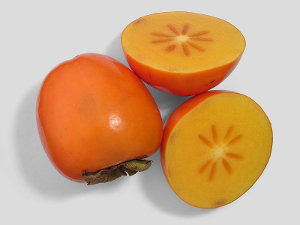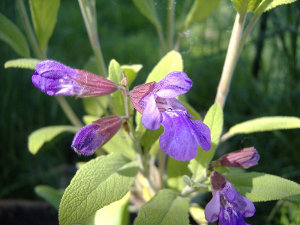Astringency in Tea
Wikipedia: AstringentLast Updated: Jan. 13, 2014
 Persimmons, when not fully ripe, are among the most astringent fruits. Photo by Olegivvit, Licensed under CC BY-SA 2.5.
Persimmons, when not fully ripe, are among the most astringent fruits. Photo by Olegivvit, Licensed under CC BY-SA 2.5.Astringency is not a flavor, but rather, a physical sensation caused by chemicals binding to the protein in saliva, and causing the tissues of the mouth to constrict. The sensation may be familiar to people who have bitten into fruit that is not fully ripe, like a persimmon or a green banana.
Most tea is somewhat astringent, more so than a lot of common food and drink. The astringency of tea is caused mainly by polyphenols, which are antioxidants, including both the catechins of green tea and the tannins that give black tea its color. Because tannins are largely responsible for the astringency of black teas, black teas exhibiting a high amount of astringency are often described as "tannic".
The relationship of tea grade, quality, and price to astringency
Too much astringency can make a tea unpleasant to drink, and there is a point at which higher grade teas with a smoother mouthfeel tend to be pricier and harder to obtain than those with a rougher mouthfeel. Some astringency, however, can be pleasant, and too little can make a tea seem watery or thin. High-quality teas usually achieve a balance of enough astringency to impart a certain amount of body to the tea, but little enough that the cup is still smooth on the palate.James Norwood Pratt cites astringency as being responsible for the refreshing quality of tea, and points to Darjeeling First Flush as a highly desirable tea which is also high in astringency.[1]
Preference for astringency is a matter of personal taste, and different people have as different preferences for mouthfeel and sensations on the palate, just as they do for flavor and aroma.
 Common sage, Salvia officinalis, produces a very astringent herbal tea. Photo by Duk, Licensed under CC BY-SA 3.0.
Common sage, Salvia officinalis, produces a very astringent herbal tea. Photo by Duk, Licensed under CC BY-SA 3.0.Astringency of herbal teas
Herbal teas can be made of any plant other than the tea plant. The amount of astringency varies widely from one herb to the next, but a typical black tea tends to be more astringent than many of the common herbal teas. A major selling point for rooibos is that it resembles black tea, yet can be steeped for a long time without becoming overly bitter or astringent.Some herbs, however, are much more astringent than tea. For example, both lavender and common sage produces a slightly sticky, resinous mouthfeel when brewed on their own as an herbal tea. For this reason, they are most often included as minor components in blends containing mostly other ingredients.
Medical uses of tea as an astringent
Substances which are astringent are called astringents. As astringents constrict or contract body tissues, they can be used to slow or stop bleeding in minor wounds or sores, or to treat minor skin irritation. The astringent activity of tea is frequently referenced in material on home remedies involving applying tea bags to the skin. For example, Health Magazine recommends topical application of green tea to relieve scrapes, bug bites, and/or sunburn.[2]While the astringency of tea and the medical use of other astringents is well-documented scientifically, we were unable to find any studies on the effectiveness of this use of tea as an astringent as a home remedy, nor on the effectiveness of tea as an ingredient in skin care products.
There are many herbs with well-documented uses as astringents. Cinnamon bark and red raspberry leaf are among those commonly used in herbal teas, which are documented as astringents.[3]
References
1. James Norwood Pratt, Tea Dictionary, 2010, pp. 28.
2. The Healing Power of Tea: First-Aid Fix, Health Magazine, Health.com. Retrieved Jan. 4, 2014.
3. Joanne Barnes, Linda A. Anderson, and J. David Phillipson, Herbal Medicines, 2nd ed, Pharmaceutical Press, London, 2002.
More on astringency in tea
Astringency: The Red-Headed Stepchild of Tea's Flavors, TeaNerd, Apr. 9, 2007.

